一、理论部分
1、栈
(1)栈是一种特殊的线性表,是一种后进先出的结构。
(2)栈是限定仅在表尾进行插入和删除运算的线性表,表尾称为栈顶,表头称为栈底。
(3)栈的物理存储可以用顺序存储结构,也可以用链式存储结构。
2、队列
(1)队列是限定所有的插入只能在表的一端进行,而所有的删除都在表的另一端进行的线性表。
(2)表中允许插入的一端称为队尾,允许删除的一端称为队头。
(3)队列的操作是按先进先出的原则进行的。
(4)队列的物理存储可以用顺序存储结构,也可以用链式存储结构。
3、散列表又称为哈希表。散列表算法的基本思想是:以结点的关键字为变量,通过一定的函数关系计算出对应的函数值,以这个值作为该结点存储在散列表中的地址。
4、JAVA的集合框架实现对各种数据结构的封装,以降低对数据管理与处理的难度。
5、所谓框架就是一个类库的集合,框架中包含很多超类,编程者创建这些超类的子类可较方便的设计设计程序所需的类。例如:Swing类包
6、Java的集合类包含在java.util包中。
7、集合类的特点
(1)只容纳对象。
(2)集合类容纳的对象都是Object类的实例,一旦把一个对象置入集合类中,它的类信息将丢失,这样设计的目的是为了集合类的通用性。
8、Vector类
(1)Vector类类似长度可变的数组。
(2)Vector中只能存放对象。
(3)Vector的元素通过下标进行访问。
(4) Vector类关键属性:a.capacity表示集合最多能容纳的元素个数。b.capacityIncrement表示每次增加多少容量。c.size表示集合当前元素个数。
9、Stack类是Vector的子类。
10、Hashtable通过键来查找元素。Hashtable用散列码(hashcode)来确定键。所有对象都有一个散列码,可以通过Object类的hashCode()方法获得。
11、集合框架中的基本接口
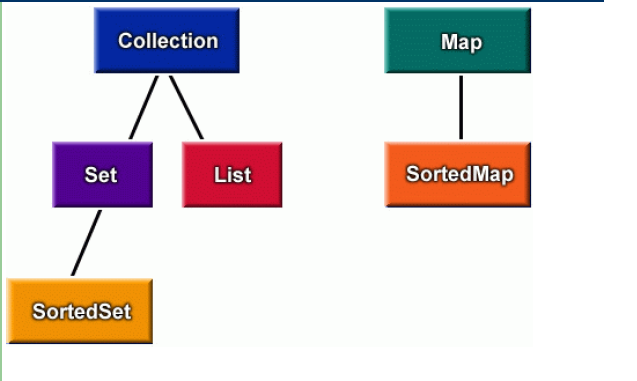
二、实验部分
1、实验目的与要求
(1) 掌握Vetor、Stack、Hashtable三个类的用途及常用API;
(2) 了解java集合框架体系组成;
(3) 掌握ArrayList、LinkList两个类的用途及常用API。
(4) 了解HashSet类、TreeSet类的用途及常用API。
(5)了解HashMap、TreeMap两个类的用途及常用API;
(6) 结对编程(Pair programming)练习,体验程序开发中的两人合作。
2、实验内容和步骤
实验1: 导入第9章示例程序,测试程序并进行代码注释。
测试程序1:
l 使用JDK命令运行编辑、运行以下三个示例程序,结合运行结果理解程序;
l 掌握Vetor、Stack、Hashtable三个类的用途及常用API。
|
//示例程序1 import java.util.Vector; class Cat { private int catNumber; Cat(int i) { catNumber = i; } void print() { System.out.println("Cat #" + catNumber); } } class Dog { private int dogNumber; Dog(int i) { dogNumber = i; } void print() { System.out.println("Dog #" + dogNumber); } } public class CatsAndDogs { public static void main(String[] args) { Vector cats = new Vector(); for (int i = 0; i < 7; i++) cats.addElement(new Cat(i)); cats.addElement(new Dog(7)); for (int i = 0; i < cats.size(); i++) ((Cat) cats.elementAt(i)).print(); } } |
|
//示例程序2 import java.util.*; public class Stacks { static String[] months = { "1", "2", "3", "4" }; public static void main(String[] args) { Stack stk = new Stack(); for (int i = 0; i < months.length; i++) stk.push(months[i]); System.out.println(stk); System.out.println("element 2=" + stk.elementAt(2)); while (!stk.empty()) System.out.println(stk.pop()); } } |
|
//示例程序3 import java.util.*; class Counter { int i = 1; public String toString() { return Integer.toString(i); } } public class Statistics { public static void main(String[] args) { Hashtable ht = new Hashtable(); for (int i = 0; i < 10000; i++) { Integer r = new Integer((int) (Math.random() * 20)); if (ht.containsKey(r)) ((Counter) ht.get(r)).i++; else ht.put(r, new Counter()); } System.out.println(ht); } } |
示例程序1更改后的代码如下:
import java.util.Vector; class Cat { private int catNumber; Cat(int i) { catNumber = i; } void print() { System.out.println("Cat #" + catNumber); } } class Dog { private int dogNumber; Dog(int i) { dogNumber = i; } void print() { System.out.println("Dog #" + dogNumber); } } public class CatsAndDogs { public static void main(String[] args) { Vector cats = new Vector(); for (int i = 0; i < 7; i++) cats.addElement(new Cat(i)); cats.addElement(new Dog(7)); for (int i = 0; i < cats.size(); i++) if(cats.elementAt(i) instanceof Cat) { //instanceof判断类型是否匹配 ((Cat) cats.elementAt(i)).print(); } else { ((Dog) cats.elementAt(i)).print(); } } }
示例程序1的实验结果如下图所示:

更改后的实验结果如下图所示:
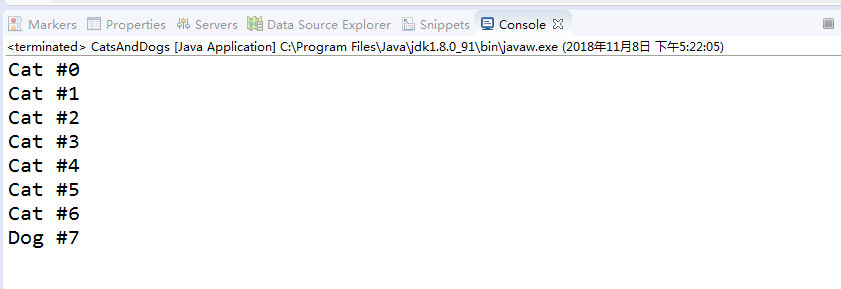
示例程序2的实验结果如下图所示:

示例程序3的实验结果如下图所示:

测试程序2:
l 使用JDK命令编辑运行ArrayListDemo和LinkedListDemo两个程序,结合程序运行结果理解程序;
|
import java.util.*; public class ArrayListDemo { public static void main(String[] argv) { ArrayList al = new ArrayList(); // Add lots of elements to the ArrayList... al.add(new Integer(11)); al.add(new Integer(12)); al.add(new Integer(13)); al.add(new String("hello")); // First print them out using a for loop. System.out.println("Retrieving by index:"); for (int i = 0; i < al.size(); i++) { System.out.println("Element " + i + " = " + al.get(i)); } } } |
|
import java.util.*; public class LinkedListDemo { public static void main(String[] argv) { LinkedList l = new LinkedList(); l.add(new Object()); l.add("Hello"); l.add("zhangsan"); ListIterator li = l.listIterator(0); while (li.hasNext()) System.out.println(li.next()); if (l.indexOf("Hello") < 0) System.err.println("Lookup does not work"); else System.err.println("Lookup works"); } } |
import java.util.*; public class ArrayListDemo { public static void main(String[] argv) { ArrayList al = new ArrayList(); // 向ArrayList添加很多元素… al.add(new Integer(11)); al.add(new Integer(12)); al.add(new Integer(13));//整型包装器类对象 al.add(new String("hello"));//字符串类对象,说明集合中的元素的类型可以不同 // 首先使用for循环将它们打印出来。 System.out.println("Retrieving by index:"); for (int i = 0; i < al.size(); i++) { System.out.println("Element " + i + " = " + al.get(i)); } } }
实验结果如下图所示:


l 在Elipse环境下编辑运行调试教材360页程序9-1,结合程序运行结果理解程序;
l 掌握ArrayList、LinkList两个类的用途及常用API。
package linkedList; import java.util.*; /** * This program demonstrates operations on linked lists. * @version 1.11 2012-01-26 * @author Cay Horstmann */ public class LinkedListTest { public static void main(String[] args) { List<String> a = new LinkedList<>(); a.add("Amy"); a.add("Carl"); a.add("Erica"); List<String> b = new LinkedList<>(); b.add("Bob"); b.add("Doug"); b.add("Frances"); b.add("Gloria"); // 把单词从b合并到a ListIterator<String> aIter = a.listIterator(); Iterator<String> bIter = b.iterator(); while (bIter.hasNext()) { if (aIter.hasNext()) aIter.next(); aIter.add(bIter.next()); } System.out.println(a); // 从b中删除每一个单词 bIter = b.iterator(); while (bIter.hasNext()) { bIter.next(); // 跳过一个元素 if (bIter.hasNext()) { bIter.next(); // 跳过下一个元素 bIter.remove(); // 删除该元素 } } System.out.println(b); // 批量操作:将b中的所有单词从a中删除 a.removeAll(b); System.out.println(a); } }
实验结果如下图所示:

测试程序3:
l 运行SetDemo程序,结合运行结果理解程序;
|
import java.util.*; public class SetDemo { public static void main(String[] argv) { HashSet h = new HashSet(); //也可以 Set h=new HashSet() h.add("One"); h.add("Two"); h.add("One");// 重复的 h.add("Three"); Iterator it = h.iterator(); while (it.hasNext()) { System.out.println(it.next()); } } } |
实验结果如下图所示:

l 在Elipse环境下调试教材365页程序9-2,结合运行结果理解程序;了解HashSet类的用途及常用API。
package set; import java.util.*; /** * This program uses a set to print all unique words in System.in. * @version 1.12 2015-06-21 * @author Cay Horstmann */ public class SetTest { public static void main(String[] args) { Set<String> words = new HashSet<>(); //HashSet实现集 long totalTime = 0; try (Scanner in = new Scanner(System.in)) { while (in.hasNext()) { String word = in.next(); long callTime = System.currentTimeMillis(); words.add(word); callTime = System.currentTimeMillis() - callTime; totalTime += callTime; } } Iterator<String> iter = words.iterator(); for (int i = 1; i <= 20 && iter.hasNext(); i++) System.out.println(iter.next()); System.out.println(". . ."); System.out.println(words.size() + " distinct words. " + totalTime + " milliseconds."); } }
l 在Elipse环境下调试教材367页-368程序9-3、9-4,结合程序运行结果理解程序;了解TreeSet类的用途及常用API。
package treeSet; import java.util.*; /** * This program sorts a set of item by comparing their descriptions. * @version 1.12 2015-06-21 * @author Cay Horstmann */ public class TreeSetTest { public static void main(String[] args) { SortedSet<Item> parts = new TreeSet<>(); parts.add(new Item("Toaster", 1234)); parts.add(new Item("Widget", 4562)); parts.add(new Item("Modem", 9912)); System.out.println(parts); NavigableSet<Item> sortByDescription = new TreeSet<>( Comparator.comparing(Item::getDescription)); sortByDescription.addAll(parts); System.out.println(sortByDescription); } }
package treeSet; import java.util.*; /** * An item with a description and a part number. */ public class Item implements Comparable<Item> { private String description; private int partNumber; /** * Constructs an item. * * @param aDescription * the item's description * @param aPartNumber * the item's part number */ public Item(String aDescription, int aPartNumber) { description = aDescription; partNumber = aPartNumber; } /** * Gets the description of this item. * * @return the description */ public String getDescription() { return description; } public String toString() { return "[description=" + description + ", partNumber=" + partNumber + "]"; } public boolean equals(Object otherObject) { if (this == otherObject) return true; if (otherObject == null) return false; if (getClass() != otherObject.getClass()) return false; Item other = (Item) otherObject; return Objects.equals(description, other.description) && partNumber == other.partNumber; } public int hashCode() { return Objects.hash(description, partNumber); } public int compareTo(Item other) { int diff = Integer.compare(partNumber, other.partNumber); return diff != 0 ? diff : description.compareTo(other.description); } }
实验结果如下图所示:

测试程序4:
l 使用JDK命令运行HashMapDemo程序,结合程序运行结果理解程序;
|
import java.util.*; public class HashMapDemo { public static void main(String[] argv) { HashMap h = new HashMap(); // The hash maps from company name to address. h.put("Adobe", "Mountain View, CA"); h.put("IBM", "White Plains, NY"); h.put("Sun", "Mountain View, CA"); String queryString = "Adobe"; String resultString = (String)h.get(queryString); System.out.println("They are located in: " + resultString); } } |
import java.util.*; public class HashMapDemo { public static void main(String[] argv) { HashMap h = new HashMap(); // 哈希映射从公司名称到地址。 h.put("Adobe", "Mountain View, CA"); h.put("IBM", "White Plains, NY"); h.put("Sun", "Mountain View, CA"); String queryString = "Adobe"; String resultString = (String)h.get(queryString); System.out.println("They are located in: " + resultString); } }
实验结果如下图所示:

l 在Elipse环境下调试教材373页程序9-6,结合程序运行结果理解程序;
l 了解HashMap、TreeMap两个类的用途及常用API。
package map; import java.util.*; /** * This program demonstrates the use of a map with key type String and value type Employee. * @version 1.12 2015-06-21 * @author Cay Horstmann */ public class MapTest { public static void main(String[] args) { Map<String, Employee> staff = new HashMap<>(); staff.put("144-25-5464", new Employee("Amy Lee")); staff.put("567-24-2546", new Employee("Harry Hacker")); staff.put("157-62-7935", new Employee("Gary Cooper")); staff.put("456-62-5527", new Employee("Francesca Cruz")); // 打印所有条目 System.out.println(staff); // 删除一个条目 staff.remove("567-24-2546"); // 替换一个条目 staff.put("456-62-5527", new Employee("Francesca Miller")); // 查找一个值 System.out.println(staff.get("157-62-7935")); // 遍历所有条目 staff.forEach((k, v) -> System.out.println("key=" + k + ", value=" + v)); } }
package map; /** * A minimalist employee class for testing purposes. */ public class Employee { private String name; private double salary; /** * Constructs an employee with $0 salary. * @param n the employee name */ public Employee(String name) { this.name = name; salary = 0; } public String toString() { return "[name=" + name + ", salary=" + salary + "]"; } }
实验结果如下图所示:

实验2:结对编程练习:
l 关于结对编程:以下图片是一个结对编程场景:两位学习伙伴坐在一起,面对着同一台显示器,使用着同一键盘,同一个鼠标,他们一起思考问题,一起分析问题,一起编写程序。
l 关于结对编程的阐述可参见以下链接:
http://www.cnblogs.com/xinz/archive/2011/08/07/2130332.html
http://en.wikipedia.org/wiki/Pair_programming
l 对于结对编程中代码设计规范的要求参考:
http://www.cnblogs.com/xinz/archive/2011/11/20/2255971.html
以下实验,就让我们来体验一下结对编程的魅力。
l 确定本次实验结对编程合作伙伴;
l 各自运行合作伙伴实验九编程练习1,结合使用体验对所运行程序提出完善建议;
l 各自运行合作伙伴实验十编程练习2,结合使用体验对所运行程序提出完善建议;
l 采用结对编程方式,与学习伙伴合作完成实验九编程练习1;
l 采用结对编程方式,与学习伙伴合作完成实验十编程练习2。
本次结对编程伙伴:王玉兰
实验九编程练习1:
package IDcard; import java.io.BufferedReader; import java.io.File; import java.io.FileInputStream; import java.io.FileNotFoundException; import java.io.IOException; import java.io.InputStreamReader; import java.util.ArrayList; import java.util.Scanner; import java.util.Collections; public class ID { public static People findPeopleByname(String name) { People flag = null; for (People people : peoplelist) { if(people.getName().equals(name)) { flag = people; } } return flag; } public static People findPeopleByid(String id) { People flag = null; for (People people : peoplelist) { if(people.getnumber().equals(id)) { flag = people; } } return flag; } private static ArrayList<People> agenear(int yourage) { // TODO Auto-generated method stub int j=0,min=53,d_value=0,k = 0; ArrayList<People> plist = new ArrayList<People>(); for (int i = 0; i < peoplelist.size(); i++) { d_value = peoplelist.get(i).getage() > yourage ? peoplelist.get(i).getage() - yourage : yourage - peoplelist.get(i).getage() ; k = d_value < min ? i : k; min = d_value < min ? d_value : min; } for(People people : peoplelist) { if(people.getage() == peoplelist.get(k).getage()) { plist.add(people); } } return plist; } private static ArrayList<People> peoplelist; public static void main(String[] args) { peoplelist = new ArrayList<People>(); Scanner scanner = new Scanner(System.in); File file = new File("D:\身份证号.txt"); try { FileInputStream files = new FileInputStream(file); BufferedReader in = new BufferedReader(new InputStreamReader(files)); String temp = null; while ((temp = in.readLine()) != null) { String[] information = temp.split("[ ]+"); People people = new People(); people.setName(information[0]); people.setnumber(information[1]); int A = Integer.parseInt(information[3]); people.setage(A); people.setsex(information[2]); for(int j = 4; j<information.length;j++) { people.setplace(information[j]); } peoplelist.add(people); } } catch (FileNotFoundException e) { System.out.println("文件未找到"); e.printStackTrace(); } catch (IOException e) { System.out.println("文件读取错误"); e.printStackTrace(); }//捕获异常 boolean isTrue = true; while (isTrue) { System.out.println("******************************************"); System.out.println(" 1.按姓名典序输出人员信息"); System.out.println(" 2.查询最大年龄人员信息"); System.out.println(" 3.查询最小年龄人员信息"); System.out.println(" 4.输入你的年龄,查询身份证号.txt中年龄与你最近的人"); System.out.println(" 5.查询人员中是否有你的同乡"); System.out.println(" 6.退出"); System.out.println("******************************************"); int nextInt = scanner.nextInt(); switch (nextInt) { case 1: Collections.sort(peoplelist); System.out.println(peoplelist.toString()); break; case 2: int max=0; int j,k1 = 0; for(int i=1;i<peoplelist.size();i++) { j = peoplelist.get(i).getage(); if(j>max) { max = j; k1 = i; } } System.out.println("年龄最大:"+peoplelist.get(k1)); break; case 3: int min = 100; int j1,k2 = 0; for(int i=1;i<peoplelist.size();i++) { j1 = peoplelist.get(i).getage(); if(j1<min) { min = j1; k2 = i; } } System.out.println("年龄最小:"+peoplelist.get(k2)); break; case 4: System.out.println("年龄:"); int input_age = scanner.nextInt(); ArrayList<People> plist = new ArrayList<People>(); plist = agenear(input_age); for(People people : plist) { System.out.println(people.toString()); } break; case 5: System.out.println("请输入省份"); String find = scanner.next(); for (int i = 0; i <peoplelist.size(); i++) { String [] place = peoplelist.get(i).getplace().split(" "); for(String temp : place) { if(find.equals(temp)) { System.out.println("你的同乡是 "+peoplelist.get(i)); break; } } } break; case 6: isTrue = false; System.out.println("byebye!"); break; default: System.out.println("输入有误"); } } } }
package IDcard; public class People implements Comparable<People> { private String name = null; private String number = null; private int age = 0; private String sex = null; private String place = null; public String getName() { return name; } public void setName(String name) { this.name = name; } public String getnumber() { return number; } public void setnumber(String number) { this.number = number; } public int getage() { return age; } public void setage(int age ) { this.age = age; } public String getsex() { return sex; } public void setsex(String sex ) { this.sex = sex; } public String getplace() { return place; } public void setplace(String place) { if(this.place == null) { this.place = place; }else { this.place = this.place+ " " +place; } } public int compareTo(People o) { return this.name.compareTo(o.getName()); } public String toString() { return name+" "+sex+" "+age+" "+number+" "+place+" "; } }
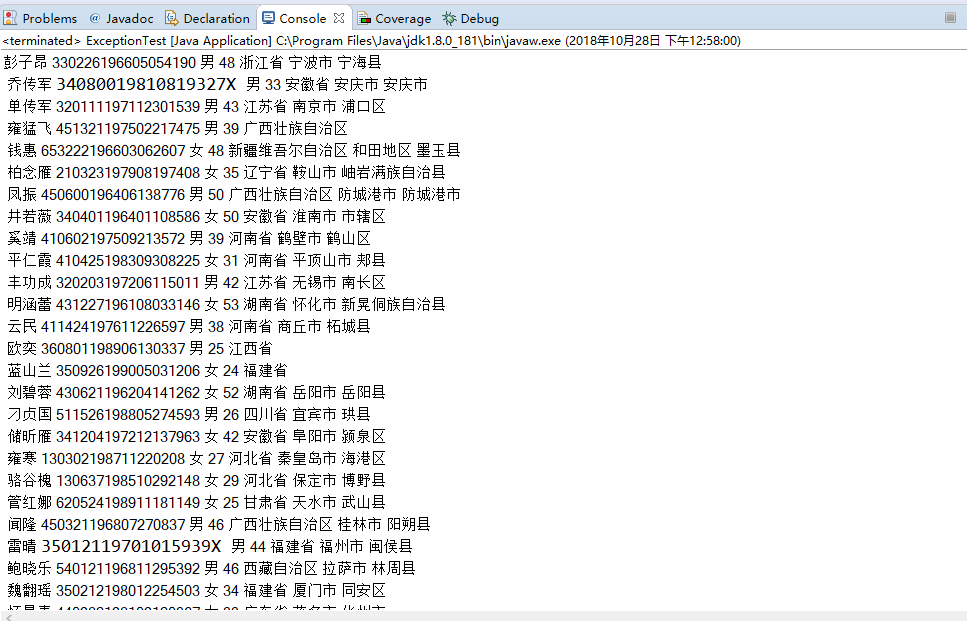
import java.io.BufferedReader; import java.io.File; import java.io.FileInputStream; import java.io.FileNotFoundException; import java.io.IOException; import java.io.InputStreamReader; import java.util.ArrayList; import java.util.Arrays; import java.util.Scanner; import java.util.Collections;//对集合进行排序、查找、修改等; public class Test { private static ArrayList<Citizen> citizenlist; public static void main(String[] args) { citizenlist = new ArrayList<>(); Scanner scanner = new Scanner(System.in); File file = new File("E:/java/身份证号.txt"); //异常捕获 try { FileInputStream fis = new FileInputStream(file); BufferedReader in = new BufferedReader(new InputStreamReader(fis)); String temp = null; while ((temp = in.readLine()) != null) { Scanner linescanner = new Scanner(temp); linescanner.useDelimiter(" "); String name = linescanner.next(); String id = linescanner.next(); String sex = linescanner.next(); String age = linescanner.next(); String birthplace = linescanner.nextLine(); Citizen citizen = new Citizen(); citizen.setName(name); citizen.setId(id); citizen.setSex(sex); // 将字符串转换成10进制数 int ag = Integer.parseInt(age); citizen.setage(ag); citizen.setBirthplace(birthplace); citizenlist.add(citizen); } } catch (FileNotFoundException e) { System.out.println("信息文件找不到"); e.printStackTrace(); } catch (IOException e) { System.out.println("信息文件读取错误"); e.printStackTrace(); } boolean isTrue = true; while (isTrue) { System.out.println("1.按姓名字典序输出人员信息"); System.out.println("2.查询最大年龄的人员信息、查询最小年龄人员信息"); System.out.println("3.查询人员中是否查询人员中是否有你的同乡"); System.out.println("4.输入你的年龄,查询文件中年龄与你最近人的姓名、身份证号、年龄、性别和出生地"); System.out.println("5.退出"); int nextInt = scanner.nextInt(); switch (nextInt) { case 1: Collections.sort(citizenlist); System.out.println(citizenlist.toString()); break; case 2: int max = 0, min = 100; int m, k1 = 0, k2 = 0; for (int i = 1; i < citizenlist.size(); i++) { m = citizenlist.get(i).getage(); if (m > max) { max = m; k1 = i; } if (m < min) { min = m; k2 = i; } } System.out.println("年龄最大:" + citizenlist.get(k1)); System.out.println("年龄最小:" + citizenlist.get(k2)); break; case 3: System.out.println("出生地:"); String find = scanner.next(); String place = find.substring(0, 3); for (int i = 0; i < citizenlist.size(); i++) { if (citizenlist.get(i).getBirthplace().substring(1, 4).equals(place)) System.out.println("出生地" + citizenlist.get(i)); } break; case 4: System.out.println("年龄:"); int yourage = scanner.nextInt(); int near = peer(yourage); int j = yourage - citizenlist.get(near).getage(); System.out.println("" + citizenlist.get(near)); break; case 5: isTrue = false; System.out.println("程序已退出!"); break; default: System.out.println("输入有误"); } } } public static int peer(int age) { int flag = 0; int min = 53, j = 0; for (int i = 0; i < citizenlist.size(); i++) { j = citizenlist.get(i).getage() - age; if (j < 0) j = -j; if (j < min) { min = j; flag = i; } } return flag; } }
public class Student implements Comparable<Student> { private String name; private String number ; private String sex ; private int age; private String province; public String getName() { return name; } public void setName(String name) { this.name = name; } public String getnumber() { return number; } public void setnumber(String number) { this.number = number; } public String getsex() { return sex ; } public void setsex(String sex ) { this.sex =sex ; } public int getage() { return age; } public void setage(int age) { // int a = Integer.parseInt(age); this.age= age; } public String getprovince() { return province; } public void setprovince(String province) { this.province=province ; } public int compareTo(Student o) { return this.name.compareTo(o.getName()); } public String toString() { return name+" "+sex+" "+age+" "+number+" "+province+" "; } }
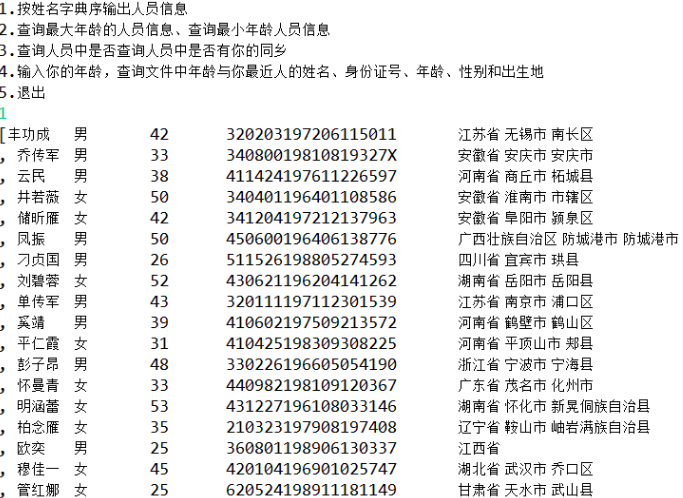
分析:代码基本大同小异,实现的功能也基本相同,但小伙伴很细心,对代码进行了注释,这点值得我学习。
实验十编程练习2:
package 改进版; import java.io.FileNotFoundException; import java.io.PrintWriter; import java.util.Random; import java.util.Scanner; public class Suanshu1 { public static void main(String[] args) { Scanner in = new Scanner(System.in); Suanshu ss = new Suanshu(); PrintWriter out = null; try { out = new PrintWriter("test.txt"); } catch (FileNotFoundException e) { System.out.println("文件夹输出失败"); e.printStackTrace(); } int sum = 0; for (int i = 1; i <= 10; i++) { int a = (int) Math.round(Math.random() * 100); int b = (int) Math.round(Math.random() * 100); int m; Random rand = new Random(); m = (int) rand.nextInt(4) + 1; System.out.println("随机生成的四则运算类型:" + m); switch (m) { case 1: a = b + (int) Math.round(Math.random() * 100); while(b == 0){ b = (int) Math.round(Math.random() * 100); } while(a % b != 0){ a = (int) Math.round(Math.random() * 100); } System.out.println(i + " " + a + "/" + b + "="); int c0 = in.nextInt(); out.println(a + "/" + b + "=" + c0); if (c0 == ss.chufa(a, b)) { sum += 10; System.out.println("right!"); } else { System.out.println("error!"); } break; case 2: System.out.println(i + " " + a + "*" + b + "="); int c = in.nextInt(); out.println(a + "*" + b + "=" + c); if (c == ss.chengfa(a, b)) { sum += 10; System.out.println("回答正确!"); } else { System.out.println("回答错误!"); } break; case 3: System.out.println(i + " " + a + "+" + b + "="); int c1 = in.nextInt(); out.println(a + "+" + b + "=" + c1); if (c1 == ss.jiafa(a, b)) { sum += 10; System.out.println("回答正确!"); } else { System.out.println("回答错误!"); } break; case 4: while (a < b) { b = (int) Math.round(Math.random() * 100); } System.out.println(i + " " + a + "-" + b + "="); int c2 = in.nextInt(); out.println(a + "-" + b + "=" + c2); if (c2 == ss.jianfa(a, b)) { sum += 10; System.out.println("回答正确!"); } else { System.out.println("回答错误!"); } break; } } System.out.println("最后得分" + sum); out.println("最后得分" + sum); out.close(); } }
package 改进版; public class Suanshu<T> { private T a; private T b; public Suanshu() { a = null; b = null; } public Suanshu(T a, T b) { this.a = a; this.b = b; } public int jiafa(int a,int b) { return a + b; } public int jianfa(int a, int b) { return a - b; } public int chengfa(int a, int b) { return a * b; } public int chufa(int a, int b) { if (b != 0 && a%b==0) return a / b; else return 0; } }
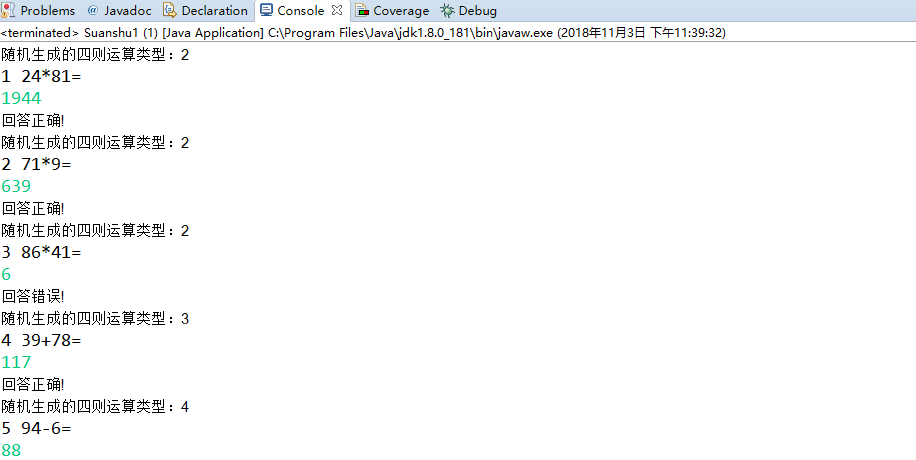

import java.io.FileNotFoundException; import java.io.PrintWriter; import java.util.Random; import java.util.Scanner; public class Suanshu { public static void main(String[] args) { Scanner in = new Scanner(System.in); Suanshu ss = new Suanshu(); PrintWriter out = null; try { out = new PrintWriter("test.txt"); } catch (FileNotFoundException e) { System.out.println("文件夹输出失败"); e.printStackTrace(); } int sum = 0; for (int i = 1; i <= 10; i++) { int a = (int) Math.round(Math.random() * 100); int b = (int) Math.round(Math.random() * 100); int m; Random rand = new Random(); m = (int) rand.nextInt(4) + 1; System.out.println("随机生成的四则运算类型:" + m); switch (m) { case 1: a = b + (int) Math.round(Math.random() * 100); while(b == 0){ b = (int) Math.round(Math.random() * 100); } while(a % b != 0){ a = (int) Math.round(Math.random() * 100); } System.out.println(i + " " + a + "/" + b + "="); int c0 = in.nextInt(); out.println(a + "/" + b + "=" + c0); if (c0 == ss.chufa(a, b)) { sum += 10; System.out.println("right!"); } else { System.out.println("error!"); } break; case 2: System.out.println(i + " " + a + "*" + b + "="); int c = in.nextInt(); out.println(a + "*" + b + "=" + c); if (c == ss.chengfa(a, b)) { sum += 10; System.out.println("回答正确!"); } else { System.out.println("回答错误!"); } break; case 3: System.out.println(i + " " + a + "+" + b + "="); int c1 = in.nextInt(); out.println(a + "+" + b + "=" + c1); if (c1 == ss.jiafa(a, b)) { sum += 10; System.out.println("回答正确!"); } else { System.out.println("回答错误!"); } break; case 4: while (a < b) { b = (int) Math.round(Math.random() * 100); } System.out.println(i + " " + a + "-" + b + "="); int c2 = in.nextInt(); out.println(a + "-" + b + "=" + c2); if (c2 == ss.jiafa(a, b)) { sum += 10; System.out.println("回答正确!"); } else { System.out.println("回答错误!"); } break; } } System.out.println("最后得分" + sum); out.println("最后得分" + sum); out.close(); } private int jiafa(int a, int b) { // TODO Auto-generated method stub return 0; } private int chengfa(int a, int b) { // TODO Auto-generated method stub return 0; } private int chufa(int a, int b) { // TODO Auto-generated method stub return 0; } }
public class Suanshu<T> { private T a; private T b; public Suanshu() { a = null; b = null; } public Suanshu(T a, T b) { this.a = a; this.b = b; } public int jiafa(int a,int b) { return a + b; } public int jianfa(int a, int b) { return a - b; } public int chengfa(int a, int b) { return a * b; } public int chufa(int a, int b) { if (b != 0 && a%b==0) return a / b; else return 0; } }


分析:代码差不多,实现的功能一致,对四则运算都进行了改进,小伙伴做得很认真,我要多多学习。
三、实验总结
通过本周的学习我了解了Java的集合框架,明白了JAVA的集合框架实现对各种数据结构的封装,以降低对数据管理与处理的难度。通过和小伙伴王玉兰对前两周的实验进行了改进,对程序有了进一步的理解,也让我认识到了自己的不足,在今后的学习中仍然需要努力。这种结对编程的方式很好,让我们有了交流,可以共同督促,共同进步。